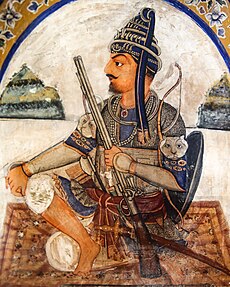
Summary
Jathedar Baba Hanuman Singh (1755 – 1846),[1] also known as Akali Hanuman Singh or Amar Shaheed Baba Hanuman Singh, was a Nihang Sikh and was the 7th Jathedar of Budha Dal and Jathedar of Akal Takhat.[2] He was the successor of Akali Phula Singh.[3][4] He was the first one who fought against the British. He attained martyrdom during a battle with the British and Patiala State in 1846.
Baba Hanuman Singh | |
|---|---|
| ਪੰਥ ਪਾਤਸ਼ਾਹ ਬਾਬਾ ਹਨੂਮਾਨ ਸਿੰਘ | |
 Mural of Hanuman Singh from Gurdwara Baba Atal in Amritsar, circa 19th century | |
| Shaheed | |
| 7th Jathedar of Akal Takht | |
| In office 1823–1846 | |
| Preceded by | Phula Singh |
| Succeeded by | Prahlad Singh |
| 7th Jathedar of Buddha Dal | |
| In office 1823–1846 | |
| Preceded by | Phula Singh |
| Succeeded by | Prahlad Singh |
| Personal details | |
| Born | Hanuman Singh November 1755 Naurang Singh Wala, Firozpur, Punjab |
| Died | 1846 (age 90–91) Sohana, Mohali, Punjab |
| Parents |
|
Biography edit
In November 1755, he was born to Garja Singh and Harnam Kaur[5] at Village Naurang Singh Wala, Zira, Ferozpur. Aged 68, he became Jathedar of Akal Takhat.
After defeat of the Sikh Empire against the British, Jathedar decided to re-group the Nihang Sikh army against the British at the Patiala Chauni. Raja Karam Singh was ruler of Patiala and other Malwa Kingdom was in alliance with British. There were strict orders to shoot Nihangs on sight. When Jathedar Hanuman Singh arrived at Patiala, Raja Karam Singh launched a cannon attack on Nihangs, in which many Nihang Singhs were killed. Rest were forced to move to the forests nearby. Hanuman Singh and around 500 Nihang warriors survived this attack, and continued to fight the heavy cannon fire of the British, with swords, bows and arrows, axes and matchlock fire.
After the battle of Sabraon, the survivors of the Budha Dal sought out respite amongst the cis-Sutlej states south of the Sutlej river. Hanuman Singh received an invitation from the ruler of Patiala State, Narinder Singh.[1]
Baba Hanuman Singh was wounded badly and died at the battle of Sohana, Mohali at the age of 90.[6] He was succeeded by Jathedar Baba Parladh Singh Nihang Singh. His memorial, Gurdwara Singh Shaheedan, is situated in Sohana.[7][8] A Kabaddi academy is present in Sohana in his name.
Gallery edit
-
Wood engraving of an 'Akali Chief' (likely Akali Hanuman Singh), by G.T. Vigne, ca.1846
References edit
- ^ a b Nihang, Nidar Singh (2008). In the master's presence : the Sikhs of Hazoor Sahib. Parmjit Singh. London: Kashi House. p. 161. ISBN 978-0-9560168-2-9. OCLC 260209971.
In the aftermath of Sobraon, the Buddha Dal survivors sought respite among the independent Sikh principalities south of the Satluj. Their elderly jathedar, Akali Hanuman Singh Nihang (d. 1846), received an invitation from the young king of Patiala, Narinder Singh (1814-1862).
- ^ The Sikh Courier, Volumes 9-12. Sikh Cultural Society of Great Britain. 1977. p. 24.
- ^ Bansal, Bobby Singh (2015). "Notes and References". Remnants of the Sikh empire : historical Sikh monuments in India and Pakistan. New Delhi, India. ISBN 978-93-84544-89-8. OCLC 934672669.
53. Akali Phula Singh was born in the village of Shinh near the town of Banga in Jalandhar district in 1761. He was the head of the fanatical sect the Akalis until his death in 1823. He was succeeded by Akali Hanuman Singh as the seventh leader of the Nihangs...
{{cite book}}: CS1 maint: location missing publisher (link) - ^ Singh, Kamalroop. "A wedding party, something old, something new: The history of the formation of the British-Sikh regiments." p. 63. HumaNetten 36 (2016): 57-80.
- ^ "nihangsingh.org". Archived from the original on 11 March 2014. Retrieved 11 March 2014.
- ^ Singh, Ishwar (2022). Akali Baba Hanuman Singh. HarperCollins. ISBN 9798888154342.
- ^ ARIHANT, EXPERTS (2018). KNOW YOUR STATE PUNJAB. [S.l.]: ARIHANT PUBLISHERS. p. 189. ISBN 978-93-131-6766-2. OCLC 1264717219.
- ^ ਬਾਬਾ ਹਨੂਮਾਨ ਸਿੰਘ ਦਾ ਜਨਮ ਦਿਹਾੜਾ ਸ਼ਰਧਾ ਨਾਲ ਮਨਾਇਆ: Retrieved from Punjabi Tribune: 04/12/2014


